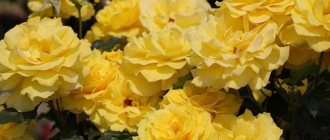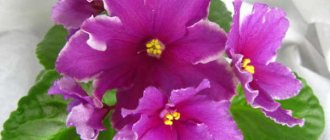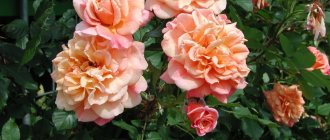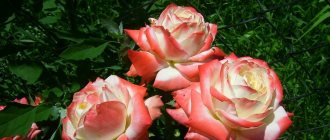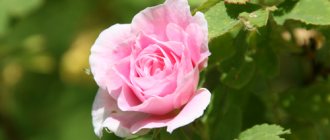Ampelous fuchsia with its long stems hanging from a hanging flowerpot gained popularity not so long ago and immediately won the hearts of all flower lovers who appreciated its decorative charms and characteristic properties. Several flowerpots with an ampelous variety of this plant can skillfully decorate a porch, balcony, terrace, veranda or a fairly large wall of a house.
Description
Fuchsia is a perennial plant of the Fireweed family. Thanks to the numerous variety of ornamental varieties with unusual bright colors, this tenacious evergreen flower has deservedly taken its place of honor among ornamental plants. Many hybrid forms of fuchsia are known: with straight stems, with pyramidal ones, spreading, hanging, climbing, in the form of a bush or tree. Of particular interest in modern design is ampelous fuchsia with thin stems forming a crown in the form of a cascade. The length of the bright green oval-shaped leaves with sharp tips is about 5 cm.
The variety of flower colors is amazing in its diversity: white, red, pink, blue, light blue, purple, yellow. The flowers themselves have an unusual shape due to the protruding stamens from under a lush petal skirt that emerges from a tubular corolla.
In the modern world, fuchsia was previously known only as a houseplant that blooms all year round. But over time, it increasingly began to appear on the street in the warm season, decorating the exterior of houses and flower beds of gardens. About ten thousand varieties of this plant are known in the world.
With proper care, it can bloom from spring to autumn, its peak flowering is in April and October. The plant is so unpretentious that gardeners find caring for it a pleasure.
History of the development of the Ballerina variety
At the beginning of the last century, the German breeder Peter Lambert, while breeding new varieties of roses, developed “Trier” - a variety of the “queen of flowers”, which became the first representative of a new species - musk roses. This variety created a sensation among specialists and flower growers from around the world. Trier had a strong, pleasant aroma and repeated flowering throughout the season.
Photo of rose Ballerina
Peter Lambert's students, the Bentall couple, as well as breeders from other countries, such as the English breeder Joseph Pemberton, began breeding other varieties of roses from the musk rose series.
And in Belgium, a whole Lens Rosen nursery was opened by breeder Louis Lenet, in which, from the moment of its opening to the present day, new varieties of the “queen of flowers” with various colors of petals, wonderful aromas, long-lasting flowering and other positive characteristics have been bred and grown.
How the Ballerina rose blooms - video
The musk rose variety Ballerina was created by the Bentall couple at the beginning of the last century
. Since then, this rose has been exhibited at many international flower exhibitions, where it received high awards.
Varieties for growing in pots
Fuchsia is native to South America and New Zealand. It was from there that many varieties of this plant were brought. Ampelous fuchsia was recently bred. There are known double, semi-double and simple varieties, some of which we will briefly consider.
- «Holly's Beauty" is a flower variety in white and pink tones, with double petals.
- «Prince of Peace" is a plant that blooms ordinary flowers with white sepals and a red skirt.
- «Blue Angel" is a plant variety famous for its chic combination of lilac and purple shades of flowering, edged with white sepals.
- «Imperial Crown"- a plant with elongated scarlet flowers collected in clusters.
- «Bicentennial"- an ampelous variety with oblong, rather large double flowers in the form of buds with sepals in light colors, which over time transform into orange.
- «Marinka"- ampelous fuchsia, the flowers of which are ordinary and monochromatic, but look wonderful due to their extraordinary brightness and abundance.
- «Santa Clara" - a variety with large double flowers, consisting of a cherry-colored “skirt” and white sepals.
- «Niedersachsen"- a very spectacular fuchsia with large double flowers, whose sepals are red with a white edge. The popular name for this fuchsia is “ballerina”.
- «Peachy» - ampelous fuchsia with large oblong buds. The flowers of this plant are double with white sepals with a delicate pink edge.
The following types and varieties of fuchsia can also be placed in flowerpots:
- «Annabel"- a variety in ampelous form, but can also be grown in the form of a bush; it has fairly large, white double flowers with a slight pink tint.
- Fuchsia trifoliata - bush up to 60 cm, growing horizontally. This variety is convenient to grow in pots. It has ovoid green leaves about 8 cm long, the front side of which is tinged with red and the bottom is brown. There is a small fluff on the leaves. Three-leaved fuchsia flowers in the form of a bell of red color with an orange tint are collected in several flowers in an inflorescence. Great for decorative use to create entire flower arrangements.
- Fuchsia recumbent - a creeping plant with upward-pointing flowers in pink or orange tones. Suitable for pots and flower arrangements. It blooms in the warm season with single flowers.
- Fuchsia bright red - a luxurious plant with scarlet flowers on thin stems. The oval-shaped leaves are placed on small petioles.
- «Archie Owen» is a semi-ampelous variety with impressively sized flowers in pink tones.
- «Bella Rosella"is one of the few fuchsias with the largest double flowers in lilac and pink colors.
- «Blue Mirage" is a plant that can be either in a hanging form or in the form of a bush. It has amazing deep purple flowers with white sepals.
- «Blue Veil"- a plant with beautiful lilac petals, bordered by white sepals with green tips. It can grow in a hanging form and as a bush.
- «Cecile“is an unusually beautiful ampelous bush plant with wavy lavender petals of dense flowers and pink sepals.
In flowerpots, all ampelous varieties of this plant look simply unsurpassed; they can transform even the most modest exterior of a house.
Conditions for fuchsia
If you create comfortable growing conditions for ampelous fuchsia and provide it with proper care at home, then it can delight others for many years.
Lighting and temperature
Ampel varieties of fuchsia feel comfortable in partial shade or in light with moderate brightness, do not like direct sunlight, and do not tolerate drafts and cool air. Direct sunlight has a depressing effect on them: the plant will not die, but the flowers will become very small, the leaves will thin out significantly, and it will be almost impossible to return to its former luxurious appearance. All these factors must be taken into account when placing them.
Fuchsia feels much better in a place where it receives sunbathing only in the morning, and from midday until sunset it is advisable for it to be in partial shade. The eastern side, as well as the southwestern side, suits her best. But it should be noted that with a long stay of this flower in a shady place, the number of flowers noticeably decreases.
If there is not enough light for a long time, the plant will not bloom or may die. In this case, it must be moved to a brighter place; if this is not possible, then artificial lighting can help out.
The optimal temperature for growing fuchsia should be approximately +22 °C during the day and not lower than +15 at night. Very high and low temperatures negatively affect the flowering process. The plant adapts to temperature conditions: when there is a lot of light and heat around, flowering cannot be stopped (spring, summer, autumn), but if it gets colder, buds no longer appear, flower development slows down (at the end of the autumn period, in winter).
Container size and substrate
All parts of fuchsia do not like high temperatures, including its rather delicate roots.
In an ordinary pot, the roots can easily overheat. If the plant will overwinter on a windowsill indoors, then thermal insulation must be made under the container.
Fuchsia is not very demanding on the soil for growing, but it feels more comfortable in fertile, neutrally acidic soil with easy air access, and for this the soil must be porous. There are several options for combining the components of an earthen mixture intended for growing this flower; it is also acceptable to use a ready-made mixture for any plant. The substrate for fuchsia can consist of peat, humus, turf and leaf soil, sand, and expanded clay can be used for drainage. The earthen mixture is also made from peat, sand, perlite and clay.
Planting and propagation
The processes of planting ampelous fuchsia, propagating and caring for it have a number of features that must be adhered to. Propagation of this plant is best done in early spring using cuttings or planting seeds. The first method is much simpler.
Seed method
At home, fuchsia is grown by seed extremely rarely, except for the purpose of experimenting. This process is quite complex and has many nuances, but it cannot be said that it is ineffective.
Seeds can be purchased at a specialty store. They can also be collected from a house plant, which is a very entertaining process. First, you need to avoid self-pollination; for this purpose, you need to tear off the anthers on the flower and place pollen of the desired variety on the stamens.
After this, wrap the bud in gauze and secure it with a thread; it will remain in this state for less than a month, until the fruit appears. All this time, any movement of the flower is contraindicated. The finished fruit is removed, carefully cut and the seeds are removed, which need to be dried.
Only after this are the seeds ready for sowing, which is best done in early spring. Fuchsia seeds are placed on the surface in wooden boxes with a mixture of peat and coarse sand and pressed lightly with your fingers. It is not recommended to plant seeds deep into the soil: they may not sprout.
The boxes are covered in the form of a small greenhouse with sufficient lighting without direct sunlight, creating the necessary humidity and temperature within 18–22 ° C. Regularly, once a day, the greenhouse must be opened for ventilation for several minutes, and the condensation that has formed must be removed and watered with settled water at room temperature using a sprayer. If you approach this process responsibly, sprouts will appear in a maximum of two weeks.
After sprouting, the greenhouse can be left open for a longer time each time so that the sprouts quickly get used to normal humidity and room temperature. After the young plants have grown noticeably and become accustomed to natural conditions, they are transplanted one by one into separate pots, before which the plants and fertile fertilized soil are well moistened. Pots with planted young flowers are placed in a shaded place for the first time.
Further care for such plants consists of fertilizing every two weeks after planting, regularly fertilizing the soil, placing the plant in high-quality diffused lighting, systematic watering, pruning during the period of active growth, and annual replanting.
Vegetative propagation
The optimal way to propagate fuchsia is using cuttings, which can easily avoid problems: the shoots take root well. This method is more popular and much simpler than the seed method. Its main advantage is a small waste of time with excellent results. The best period for this breeding is also spring. Young shoots are ideal for cuttings, because old woody shoots take much longer to take and grow more slowly.
The length of each cutting is individual and depends largely on the variety of fuchsia; it can range from 8 to 20 cm. Before placing the shoot in settled or filtered water, you need to tear off the leaves so that none of them come into contact with the water, otherwise they will begin to rot and mold , and this will have a detrimental effect on the condition of the cutting.
Large leaves on the shoot are also not needed: they take away a lot of the moisture it needs to form a root. The glass with the shoot must be covered with polyethylene to maintain a sufficiently high humidity. If everything is done correctly, the roots on the shoot will be noticeable within a few days, but another couple of weeks are needed for the root to become full-fledged.
You can replant a young plant into the soil when the first roots appear; it is not necessary to wait for the entire root system to form, but it is still safer to wait these couple of weeks.
Further care for young flowers follows the same rules as for plants obtained from seeds. There is another way of propagation using cuttings - when they are planted directly into the substrate, but at the same time you need to make a kind of greenhouse over them, the exit from which is a little troublesome for gardeners and dangerous for the sprouted plant itself: it may even die if something is done wrong or hasty.
How to propagate fuchsia is up to each individual to decide; the main thing is to learn all the simple rules, and it will definitely take root and bloom.
Features of care
Ampelous fuchsia deservedly enjoys the love of gardeners not only for its attractive appearance, but also due to its unpretentious care in the garden, in a flower pot, in a flower bed or in a pot on the windowsill. After all, the cultivation of ampelous fuchsia can take place both in the shade in the garden and in an open space not protected from the sun; it does not make any special demands on the nutritional value of the soil and frequent watering, and you can get as much pleasure from its beauty as no other plant.
Watering and spraying
Rational watering is of great importance when growing fuchsia. How often to water this plant and how much liquid it needs is influenced by various factors: weather conditions, the type of flower, its location, stage of development, and even the size of the pot and the material from which it is made.
For irrigation, it is recommended to use settled or melt water. It is necessary to water the flower in fairly moderate quantities. During active development, the soil should be slightly moist. In the summer, spraying with fairly cool water will not hurt the ampelous fuchsia.
It is better to drain the excess water remaining after watering. From late autumn, it is enough to water the plant no more than once every two weeks. With the arrival of frost, you can practically not water the plant or do it very rarely.
Trimming
Pruning fuchsia is a must. It promotes plant rejuvenation and crown formation, and prevents the process of bare stems. Pruning is carried out annually in the spring. The shoots are cut to a third of their length along the entire circumference of the flower in order to create symmetry of the plant.
Fertilizer
Fertilizing fuchsia is necessary for its better development. A fertilized plant is noticeable from a distance: it blooms unusually beautifully and develops luxuriantly. They usually begin to fertilize these plants as soon as the first flowers appear, and continue to do this while it is actively blooming and developing. Fertilizing is done approximately once a week with liquid complex fertilizers for plants, in which it is necessary to control the nitrogen level. In winter, the flower does not need fertilizer.
Transfer
The replanting process is also very necessary for fuchsia to form, because with the new soil it receives all the necessary microelements and nutrients. Young plants are replanted once a year; older plants need to be replanted once every three years.
The transfer method is optimal for replanting fuchsia: it is carefully transferred, preserving the integrity of the old soil with the root system, and a fresh earth mixture is added to the free space of the pot, preventing the formation of a void between the root system of the flower and the walls of the pot. After this, the plant must be watered and left to adapt. In no case should you forget about the drainage layer.
agronomu.com
How to plant fuchsia sprouts
The sprouts are planted in small containers, no more than 9 cm in diameter. Drainage is required. The pot is completely filled with earth so that there are no voids. To do this, it is shaken and tapped, but not compacted by hand; the soil must be porous.
Transplantation is performed in the spring once a year. An adult bush is shortened by 1/3, the roots are trimmed (excluding hanging varieties).
The substrate used is slightly acidic, there are several options:
- sand, peat, sheet soil (1:2:3);
- sand, greenhouse, clay-turf soil, peat chips (1: 2: 3: 0.2);
- ready-made mixture for flowering plants.
Further step by step process:
- A ceramic pot is used to protect the root system from the summer heat, about 4 cm larger than the previous one.
- Pour drainage onto 1/5 of the new container (expanded clay, pebbles) to protect the plant from rotting.
- Sprinkle with substrate.
- Using the transfer method, the fuchsia is removed from the old container, without shaking off the soil, and placed in a new one. The voids are filled.
- Spray and water until moisture appears in the stand. After a while, excess liquid is removed.
- No feeding for 30 days.
- After another 60 days, flowering is expected.
General description and types of plants
Fuchsia is extremely common in its homeland. It has more than 100 species, differing in color, size and shape of flowers, flowering times, leaves, etc. All types of fuchsia growing in nature can be divided into 2 large groups :
- tree-like;
- bushy.
The most common varieties of fuchsia found in nature are:
- Fuchsia brilliant;
- Fuchsia Magellanica;
- Fuchsia corymbosa;
- Fuchsia Boliviana , etc.
For home cultivation, it is necessary to select varieties of Fuchsia hybrida . Outwardly, it looks like a small bush, all strewn with unusual flowers, which in shape are associated with a ballet tutu, i.e. just as lush and wavy.
The color range of these flowers is quite wide: from white to purple, from blue to violet. Caring for such a plant, knowing and following its basic rules, will not be difficult even for novice gardeners.
What favorable conditions need to be created for fuchsia so that it will delight you with its lush growth and abundant flowering on the windowsill at home? This should be looked at in more detail.
Caring for indoor Ficus Benjamin plants can be very simple.
One day you will need to know how to fertilize phalaenopsis orchids, about this in our article.And geranium can be propagated not only by cuttings, but also by seeds https://sad-doma.net/houseplants/dekarativnotsvetushhie/geran/geran-razmnojenie.html
Advantages of the variety
The main advantages of the Ballerina rose variety include:
- abundant flowering throughout the season;
- compact size of bushes;
- perennial resistance to stressful situations;
- frost resistance of rose Ballerina;
- resistance to most diseases.
The variety has practically no disadvantages, but among the relative disadvantages of the Ballerina rose, it should be noted that the blooming buds have no aroma, and the size of the flowers is small.
Basic rules for caring for fuchsia during the growing season
The main measures for caring for fuchsia, after its acquisition, are considered:
- correct choice of location;
- compliance with temperature and humidity conditions;
- feeding
In the life of fuchsia, two periods :
- active growth: from spring to autumn;
- relative rest: winter.
Let's consider the rules for caring for a fuchsia flower during the period of active growth . At this time, the plant should be placed on a well-lit windowsill of an eastern or western window, but not in direct sunlight. It is better not to put fuchsia on southern windows, because... she is too likely to get sunburned.
If there is no bright place in the house for fuchsia, then it should be provided with additional
artificial lighting , using, for example, fluorescent lamps.
Otherwise, fuchsia blooms may not be seen. This also applies when installing a flower on a northern windowsill with insufficient light.
The plant loves clean, often ventilated air . The presence of drafts is unacceptable. Rearrangements from place to place and rotations around its axis are not desirable for fuchsia. The air temperature during this period should be approximately +20+22 degrees.
higher ambient temperatures You can place fuchsia on a balcony, loggia, or open terrace in the summer. To prevent the sensitive root system of the plant from overheating in the heat, you need to transplant it into a wide ceramic pot.
Watering fuchsia during the growing season should be moderate: the soil should not become moldy or dry out. Water for irrigation should be used that is settled, soft, and at room temperature. In the hot season, the plant needs to create an additional humid microclimate.
Early in the morning or in the evening it is good to spray fuchsia with cool water. You can place a beautiful container with water and pebbles next to the flower, which will help create the desired microclimate around the flower.
The plant needs weekly feeding with fertilizers throughout the active period. After flowering has stopped, you can take a short break from using fertilizers. In the fall, from about September-October, fertilizing the flower is gradually stopped. As fertilizers, special fertilizers for house flowers are used with a high content of phosphorus and potassium, which are so necessary for the normal functioning of the flower.
With proper care, fuchsia will delight everyone with its long and lush flowering, from May to the end of November. A prerequisite for long-term flowering of a plant is the constant removal of faded flowers .
Throughout the growing season, the plant should be constantly pinched to form the desired shape. You need to be prepared for the fact that each pinching delays flowering for almost 2 months.
At home, fuchsia should be replanted annually . It is better to carry it out in March. The scheme for this is simple: first, drainage is placed in the pot, on which the prepared earthen mixture is placed, the plant with the earthen lump is carefully transferred and sprinkled with earth.
Using the Ballerina rose in landscape design
Ballerina rose bushes are actively used in landscape design.
Rose Ballerina in the garden
Due to its compactness and high decorative value, this variety is used as a hedge along the perimeter of plots, as well as when decorating borders.
Photo of rose Ballerina in landscape design
This rose blooms from the beginning of June until the first frost almost without interruption; after flowering, beautiful orange fruits appear in place of the buds, so the Ballerina bushes look very beautiful throughout the season.
Basic rules for caring for fuchsia during the dormant period
In winter , when caring for fuchsia, you need to take into account that the flower is in a state of sleep and dormancy.
During this period, it is important to create optimal conditions of detention. temperature during this period should not rise above 10 degrees. For this purpose, when growing a plant in a city, you can use an insulated loggia.
Good lighting and a constant flow of fresh air must be provided in sufficient quantities during the winter period. In exceptional cases, fuchsia can be left for a period of rest without light. Watering the plant in winter is significantly reduced - up to 1-2 times a month. But the soil is not allowed to dry out. During the dormant period, fuchsia should not be fertilized. It is important to know that if the specified plant care is not followed in winter, fuchsia will not bloom during the growing season.
Rose Ballerina: reviews from those who grow
Elena, 45 years old, Kazan: 4 years ago I was given 7 cuttings of the Ballerina rose. I planted one cutting separately in an empty space in light partial shade, and planted the rest as a border. A year later, overgrown bushes began to form: the free-standing bushes were spherical in shape, and those growing in the border were barrel-shaped. I constantly increase the border by propagating this rose by cuttings. I grow them in partial shade - this way the flowers fade less and the hedge looks more beautiful. I rarely water during the season, since this perennial shrub is undemanding to soil moisture. During rainy seasons, this rose does not need to be watered at all. I don’t do hilling and rarely feed them.
Varieties of roses:
Rose Midsummer variety AQUA Rose Stromboli
Zhenya, 38 years old, Belgorod region: I don’t really like musky rose varieties, but the Ballerina rose attracted me with its abundant flowering throughout the summer season. Its disadvantage is the rapid fading of the buds in the sun, so you have to grow Ballerina in a shaded area to preserve the colors of the flowers.
Propagation of fuchsia at home
With proper care of the fuchsia flower, propagated using:
- leaves;
- seeds;
- Cherenkov.
With the help of leaves, flower propagation occurs as follows: good material is selected - stems with highly developed leaves, which is sprinkled into prepared loose soil to a depth of 1-2 (cm). The leaves are moistened with warm water using a spray bottle and covered with transparent material.
Spraying the plant should occur daily. The young plant is transplanted into a pot when small rosettes appear on its stem. It is impossible to do without artificial pollination when propagating fuchsia by seeds at home.
Experienced flower growers, when cross-pollinating plants, mix several different varieties. As a result, new plant hybrids with a variety of colors of flowers and leaves are obtained.
But the cutting method of flower propagation is considered the most common. The best time for this is spring or autumn. To do this, plant cuttings 6-7 (cm) long are taken, which are placed in water or rooted in loose prepared soil consisting of humus, sand, and turf soil.
Throughout this period, the cuttings are sprayed with warm water. After about 3-4 weeks, when the young plant has formed roots, it is transplanted into a prepared pot. When you get a lush plant, you need to transplant several of these cuttings into one pot. To the delight of many gardeners, the young plant will bloom in the same year.
Thus, fuchsia, with proper care, will create a unique atmosphere of comfort, joy and light in the house.
And for the most curious, we suggest you watch a video trailer about the variety of types of fuchsia.
sad-doma.net
Problems when growing fuchsia, diseases and pests
With insufficient care and non-compliance with the rules of agricultural technology, the plant suffers from various diseases.
| Manifestation | Cause | Corrective measures |
| Curling of leaves. | Fever. | They shade. |
| Falling leaves. | Lack of lighting, low air humidity. | Spray in hot weather. |
| Dropping buds. | Excessive or incomplete watering, lack of light and nutrition. Plant disturbance during the growing season. | Provide the correct watering regime. Do not disturb when buds are pouring. Feed correctly. |
| Flowering is short and small. | The rest period took place in too warm conditions. | Provides coolness during winter. |
| Browning of foliage. | Overmoistening at low temperatures. | Reduce watering. |
| Root rot. | Excessive watering and spraying, stagnation in the pan. | Treated with fungicides (Fitosporin). Reduce watering |
| Covering leaves with white cobwebs. | Spider mite. | Spray with acaricide (Fitoverm) 3-4 times every 7 days. |
| The appearance of white insects. | Whitefly. | Insecticides are used (Aktara, Fufanon). 6-7 times every 3 days. |
DESCRIPTION AND GENERAL INFORMATION ABOUT FUCHSIA
The fuchsia genus includes more than 100 species. In home floriculture, fuchsia has become especially popular after the development of hybrids that are easily propagated by seeds and begin to bloom in the first year of life.
The oval leaves of fuchsia are slightly pointed at the edges and are usually attached to the stem opposite each other. The color of the leaves is green or slightly reddish. The graceful shape of the flower is created by the combination of a bright calyx, a tubular corolla (it can also be bell-shaped or funnel-shaped) and stamens and pistil peeking out from below. The main color of the buds: pink, red, lilac, white, cream, violet, etc. Sometimes fuchsia petals can be colored in two or three colors at the same time.
A LITTLE HISTORY
Fuchsia was discovered at the end of the 17th century by the French priest Charles Plumiere. He went on a trip to South America in search of medicinal quinine. In the eastern part of the island of Haiti, a traveler found an unusual flower and named it after the famous physician and botanist Leonard Fuchs of that time. The full name was Fuchsia Triphylla Flora Coccinea. Subsequently, systematizer Carl Linnaeus simplified the name to the species F. Triphylla. Unfortunately, Plumiere was unable to bring a single plant to Europe. The generally accepted date for the discovery of fuchsia is 1703, when the researcher's notebook was published.
The flower was first brought to England in 1789. The plant was donated to the famous Kew Botanic Gardens. Much later, when F.magellanica came to Europe, new varieties and hybrids of fuchsia were developed. And at the end of the 18th - beginning of the 19th centuries, fuchsia began its victorious march across Europe. The exotic flower began to be grown both as a home and garden plant. Fuchsia is still of interest to gardeners, and in America there is even an American Fuchsia Society (AFS), whose goal is to streamline and systematize the diversity of fuchsia hybrids and varieties.
TYPES AND VARIETIES
The fuchsia genus has more than 100 species and more than 10,000 varieties. Below are just a few of them.
Bolivian (boliviensis) fuchsia
- Bolivian (boliviensis) fuchsia. The habitat of this species is Bolivia, Ecuador and Argentina. It is a small shrub about a meter tall. Small oval LEAVES (10-15 cm) have jagged edges. Large buds (6-8 cm) are dark red;
Magellan fuchsia
- The homeland of Magellan fuchsia (also graceful (gracilis) and thin (macrostemma)) is Chile. It was this species that was first brought to Europe. The plant in natural conditions reaches a height of 1 to 3 meters. The leaves are small (1-2 cm), finely toothed along the edges. The branches often have a reddish tint. Flowers of unusual purple and violet color. Drooping buds;
- brilliant or sparkling (fulgens) fuchsia grows in the Mexico region. A small shrub 1-2 m high. The oval, heart-shaped leaves are located opposite each other. The flowers are tubular, red-pink or bright red, collected in a raceme;
- The island of Haiti is considered the birthplace of triphylla fuchsia. The small shrub reaches only 50-60 cm in height. The leaves are small, oblong (1-3 cm) and have jagged edges. The underside of the leaf is colored reddish. The buds are bright coral color.
Popular varieties:
Fuchsia Dark Eyes
- Basseveldse Ezels - double white-pink-burgundy flowers;
- Bicentennial - a variety with magnificent long salmon-colored flowers;
- Dark Eyes - flowers have blue-violet sepals, dark red tubes, erect plant;
- Garden News - pale pink dainty flowers.
Fuchsia Garden News
Here are other interesting varieties: Litte Bell, Deep Purple, Quasar, Cecile, Baby Blue Eyes, Swingtime, Ballerinas, Wonderful, Blue Mirage, Margharita, Annabel and others.
Description of fuchsia
Depending on the species, the plant is a tree or a bush. The flexible branches are covered with oval-lanceolate opposite leaves of a green or slightly reddish hue. They do not exceed 5 cm, pointed at the ends and along the edge with teeth or smooth.
The flowers have an elongated tubular calyx and long stamens. After them, edible fruits appear.



